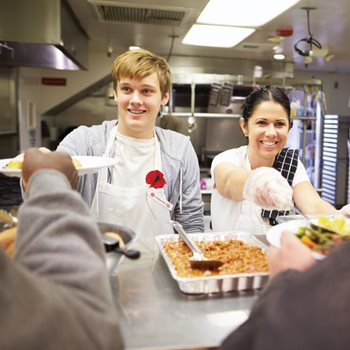Americans are spending less time volunteering — and younger people’s dwindling interest in community service has left organizations searching for ways to reach generations that represent the future of their causes.
 A 2019 study from the University of Maryland’s Do Good Institute notes that volunteering among adults age 22 to 35 decreased to about 22% in 2015, compared with nearly 26% just 12 years prior. That decrease left U.S. causes and organizations with 2.4 million fewer young volunteers.
A 2019 study from the University of Maryland’s Do Good Institute notes that volunteering among adults age 22 to 35 decreased to about 22% in 2015, compared with nearly 26% just 12 years prior. That decrease left U.S. causes and organizations with 2.4 million fewer young volunteers.
Between 2019 and 2021, rates of volunteer activity continued their decline among all demographic groups, according to a 2023 analysis from the U.S. Census Bureau and AmeriCorps.
“People are so, so busy these days that it is hard to get their attention and get them to take action,” Amanda Lea Kaiser, author of the book, Elevating Engagement: Uncommon Strategies for Creating a Thriving Member Community, shared in an email. “Younger people have significant constraints on their time while building careers, starting families, and making big financial decisions like buying a house.”
The American Legion Auxiliary is not immune from the national trend of decreasing volunteerism among younger people, said Karen Toll, the organization’s 2023-2024 national Membership Committee chair.
“If we make younger members feel welcome, they will participate,” Toll said.
But when an organization is battling a host of other commitments for interest and engagement — particularly among its younger generations of members — how can it attract attention and strengthen participation in volunteer activities?
Auxiliary magazine asked Toll, Kaiser, and ALA member Ann Rehbein — whose unit has a history of active volunteer participation among its younger members — to offer their tips on encouraging volunteer participation, especially among younger ALA members:
Go where they are. Toll, a member of ALA Unit 203 in Latonia, Ky., recommends promotional efforts that specifically target younger people where they gather. From sponsoring school sports teams to hosting social events for teens and young adults, a host of opportunities exist that can put the ALA and its activities in front of a younger audience.
Rehbein, of ALA Unit 37 in Ames, Iowa, says providing high school academic awards — with an event that honors award recipients — is another way to meet young people where they are.
“If the event is friendly and welcoming, they will want to come back,” she said.
Start with “hello.” Rehbein’s unit provides mentoring to help new members navigate ALA membership, and it starts with a simple, friendly greeting. “You can’t ignore them,” she said. “They are giving up valuable time to attend a meeting or activity, so say ‘hello’ to them and encourage them to take part in activities.”
Kaiser’s research supports this emphasis on welcoming newcomers. “First impressions are critical for first-time volunteers, and during those crucial first impressions, first-time volunteers decide to become repeat volunteers,” she said.
Focus on the experience. Consider how you want your members to feel, Kaiser says, from excitement about the work to a belief that they are part of something bigger than themselves. Then tailor your volunteer experiences to elicit those emotions.
“Neuroscience shows that emotions drive decisions to engage,” said Kaiser. “Many organizations use a super professional tone. While it conveys meaning, it doesn’t convey a lot of feeling. Warm up your tone and trigger emotions by imagining you are writing or talking to your new best friend.”
Encourage enthusiasm. An organization’s younger members often are excited about the opportunity to help, and they bring good ideas to the table, Rehbein said. Although her unit’s mentors are available to explain the history of an activity or event, they don’t discourage suggestions for changing plans and procedures.
“Don’t tamp down that enthusiasm,” she said. “Be encouraging and flexible, and try new things.”
Show gratitude. When people volunteer, they’re offering their time, ideas and, often, their money. Taking these contributions for granted can have lasting consequences. Kaiser recalled a volunteer who told her he raised more money for an event than anyone else but didn’t get a thank-you for his efforts.
“Plan how to thank every volunteer,” Kaiser said, “with public or personal thank-yous to enthusiastic volunteers who go above and beyond.”
In the spirit of Service, Not Self, the mission of the American Legion Auxiliary is to support The American Legion and to honor the sacrifice of those who serve by enhancing the lives of our veterans, military, and their families, both at home and abroad. For God and Country, we advocate for veterans, educate our citizens, mentor youth, and promote patriotism, good citizenship, peace and security.